The Featured Creatures collection provides in-depth profiles of insects, nematodes, arachnids and other organisms relevant to Florida. These profiles are intended for the use of interested laypersons with some knowledge of biology as well as academic audiences.
Introduction
Insects in the family Elateridae are commonly known as "click beetles". Their name comes from the clicking sound they make while attempting to right themselves after falling or being placed on their backs. The larvae of click beetles are called wireworms. The corn wireworm, Melanotus communis Gyllenhal, is a serious agricultural pest and was added to the EPPO A1 action list of quarantine pests in 2002 (OEPP/EPPO 2005).
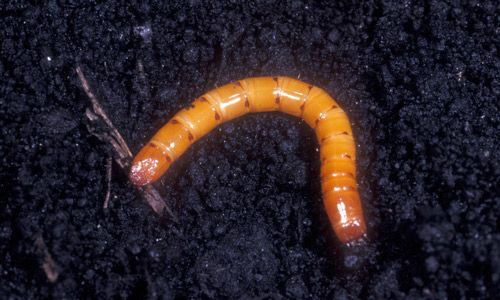
Credit: Lyle Buss, UF/IFAS
The corn wireworm is the most common wireworm of corn (Zea mays) fields in the northern central states of the U.S. and constitutes up to 85% of the total click beetle population present in the region (Riley et al. 1974, Baranowski and Waddill 1975). Wireworms are usually most severe in wet soils, and in fields that have been planted with sod, grasses, alfalfa, carrots, or potatoes. In southern Florida, at least 12 species of wireworms have been found, but the corn wireworm Melanotus communis is considered to cause significant economic damage to sugarcane (Saccharum officinarum) (Cherry et al. 2011), especially in soils rich in organic matter (Cherry and Hall 1986, Cherry 1988).
Corn wireworms are the most serious insect pests of potato. In potatoes, corn wireworms destroy planted seeds, bore into roots, crown tissues and eventually tunnel up the plant stems (Andrews et al. 2008). They feed on the seed pieces, causing weak stands, but the major yield losses are due to tunneling into tubers. These tunnels are entry points for pathogens like fungi and bacteria, leading to rotting of tubers. Out of 39 species of wireworms, 21 genera have been documented to cause damage to potatoes (Jansson and Seal 1994). During the 1980s, more than 40% of the total potato tuber harvest was down-graded or rejected because of wireworm injury in some regions of the USA (Jansson and Lecrone 1989). Southern Florida potato and sugarcane production suffer economic losses due to corn wireworm as well (Jansson and Seal 1994, Hall 1990).
Distribution
Corn wireworms occur in almost all corn-growing areas of the world. Corn wireworms are most abundant in the midwestern and southeastern states. They tend to be common in newly planted sod or no-till corn fields (Sorensen and Baker 1994).
Host Range
The corn wireworm is a major pest of corn, sugarcane, potatoes (Solanum tuberosum) and sweet potatoes (Ipomoea batatas), although wheat (Triticum aestivum), sorghum (Sorghum bicolor), unspecified grasses, small grain crops, flower and vegetable crops can also be attacked (Sorensen and Baker 1994). In addition to the above crops, corn wireworms also attack carrots (Daucus carota), cucurbits, rutabagas (Brassica napus), onions (Allium cepa), sugar beets (Beta vulgaris), beans (Phaseolus vulgaris), peas (Pisum sativum), peppers (Capsicum spp.) and celery (Apium graveolens) (Bessin and Townsend 2004, Chaput 2011, Wilson 1940).
Life History
Overwintering adults become active in early summer and start feeding on pollen. They mate and females lay eggs in the soil near the roots of grasses or other host plants. First-instar larvae emerge in July and begin feeding on roots. The larvae develop throughout the summer and overwinter as second-instar larvae in the soil. Most larval stages continue to develop over the next five years and undergo molting once or twice each year, but some larvae develop fully in three years. In the spring, mature larvae construct oval cells in the soil to pupate. Adults emerge 7–39 days later and feed on pollen before hibernating in sheltered areas (Fenton and Florence 1926). In Florida, adult Melanotus communis are most numerous during April to August, with peak oviposition in May to June (Cherry and Hall 1986). The life cycle ranges from 2–6 years depending upon species and location. In Ontario, all life stages (adult, larva, and pupa) can overwinter in infested fields (Chaput 2011).
Eggs
The eggs are tiny, white, spherical to oval shaped, 0.011 inches (0.3 mm) in diameter, and usually laid in batches of 50–130 (Andrews et al. 2008, Kuhar et al. 2008). Eggs are usually laid singly but are sometimes widely scattered on corn and other crops in Pennsylvania (Gesell 1983).
Larvae
The larvae are hard-bodied and darker colored than most maggots or grubs (Chaput 2011). The larvae are glossy and yellow-brown, with a wire-like hard, cylindrical, jointed body ranging from 0.51–1.5 inches (13–38 mm) in length. First-instar larvae are pale yellow and change to reddish brown in later stages. First-year larvae do not cause significant damage. This larval stage continues throughout summer and second instar larvae overwinter in soil. Larval period may take two to several years with one to two moltings per year. Depending on temperature and moisture, larvae move through the soil vertically on a seasonal basis. They migrate near the surface during moderate temperatures (near 70°F) and burrow in the soil in extreme heat and cold (Kuhar et al. 2008).
Pupae
Larvae pupate in the soil in oval cells 5.9–11.8 inches (15–30 cm) deep for 2 weeks. Pupae are white to cream colored, oval shaped and 0.51 inches (13 mm) in length. They are soft and fragile, seldom seen, and resemble adult beetles in size and shape (Gesell 1983). They become darker just before adult emergence.
Adults
Adults are smooth or with very short hairs, slender, 0.51 inches (13 mm) long, and reddish brown to black in color with a backward-pointing anterior projection near the middle of the narrow, tapering body. This is the only stage of wireworms that is found aboveground (Gesell 1983). They have a large tooth-like projection between the hind legs that fits into a groove on the undersurface of the abdomen. Adults feign death when disturbed and can then upright themselves from their backs by quick flexion at the juncture of the thorax and abdomen. Overwintering adult beetles emerge from soil in late March or early April and are crepuscular or nocturnal. Mated females prefer weedy or grassy fields for egg laying (Fenton and Florence 1926).
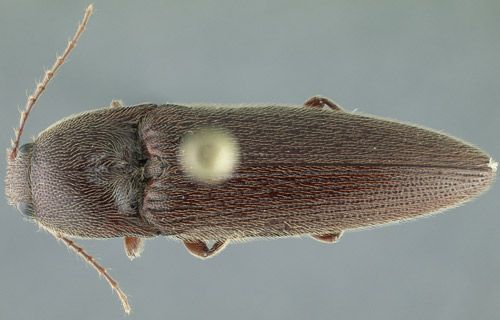
Credit: Lyle Buss, UF/IFAS
Damage
Wireworms attack mostly seeds, roots, shoots, and crowns of plants below the soil surface. In corn, damage appears in the form of hollowed-out corn kernels, leaving only the seed coat. In later stages, larvae may also cut off small roots or tunnel into underground portions of the root or stems of young corn plants. The damage can be recognized in a field by the presence of gaps in rows or stunted or wilted plants with whorl leaves wilting first (Gesell 1983). The larvae cause damage primarily to the younger plants. More damage is noticed when corn is planted in cold and wet field conditions. As soil temperatures warm, wireworms move deeper in the soil profile, eventually to where they are no longer a threat to the growing corn.
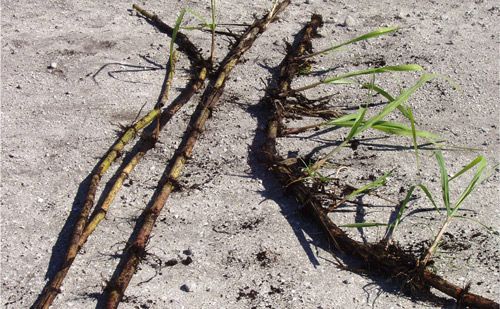
Credit: Ronald Cherry, UF/IFAS
On potato and carrot, narrow holes (about 1–3 mm (0.04 – 0.1 in) deep) are made by third-instar larvae, while deeper holes up to 3 mm (0.1 in) in diameter and 2 mm (0.08 in) deep are due to older larval instars (Jansson and Seal 1994). In potato and sweet potato, corn wireworms create larger holes in roots than holes created by other species. In northern sweet potato growing areas, Melanotus communis is the most damaging wireworm. Damaged tubers and roots are degraded and discarded due to wireworm attack (Sorensen and Baker 1994).
In sugarcane, wireworms chew into the plant base and then hollow out the stem, leading to wilting and desiccation of the youngest plants, and eventually resulting in stand loss. Soil within an 8-inch diameter around affected plants should be excavated in search of larvae in or near these plants. Wireworm damage symptoms can sometimes be confused with symptoms from lesser cornstalk borer.
Monitoring
Scouting of wireworms is very important for its management and can be achieved by using bait traps. The University of Missouri has developed wireworm traps for monitoring purposes. Traps can be placed 2–3 weeks before planting, but a week before planting is recommended when the soil temperatures are high enough for wireworms to come near the soil surface. The trap consists of a 1/2 cup of soaked seed mixture of 1:1 corn wheat, placed in a hole (6–8 inches deep in soil) and covered with soil. Soaking promotes germination and wireworms are attracted to swollen and germinating seeds (Fenton and Florence 1926). A black plastic trash bag should be placed on the soil surface surrounding the bait to maintain temperature and moisture. The edges of the trash bag should be covered with soil to keep the wind from blowing it away. Clear plastic should be placed on top of the black plastic trash bag to create a greenhouse effect.
To detect wireworms in corn, four traps per acre are needed, but it is recommended that 10 traps be used in any field as a baiting technique. To determine the threshold where economic injury occurs, collect baits after one week and count the number of wireworms. The threshold where economic injury to a corn crop can occur is more than one wireworm per trap (Rice and Simmons 1999). Sequential sampling of sugarcane fields at the pre-planting stage can be helpful to growers in determining the need for an insecticide application for controlling wireworms in Florida. Cherry et al. (2013) established an economic injury level for sugarcane of 9 or more wireworms in their sampling plan. However, the effects of 9 or more wireworms in terms of potential economic loss were not determined in their study (Cherry et al. 2013).
Management
Fields with high wireworm densities in the past tend to retain populations over the years. Fields with a long history of grass pasture or seed production were reported to be correlated with large wireworm populations, as grasses are hosts of wireworms (Anonymous 1944; Fox 1961). Low-lying areas and high organic matter also promote wireworm populations.
Biological Control
Few predators and parasitoids are reported for biological control of wireworms. In Virginia in 2002, it was found that augmentative release of entomopathogenic nematodes such as Steinernema feltiae, Steinernema riobrave or Heterorhabditis megidis was effective for wireworm control. However, replicated studies did not yield similar results. Entomopathogenic fungi such as Metarhizium anisopliae, naturally active in the soil, and pathogenic to many different kinds of insects can be exploited for biological control of wireworms.
Preliminary research in Virginia from 2007 to 2008 reported up to 50% less wireworm damage in potato when granular formulations of Metarhizium anisopliae spores were applied over the furrow at planting (Kuhar et al. 2008). Metarhizium anisopliae strain V1002 had shown considerable potential (~100% mortality) for the control of the wireworm Agriotes lineatus (Ansari et al. 2009). In southern Florida, biological control of wireworms by beneficial insects and diseases has been insignificant. Birds such as the cattle egret (Bubulcus ibis) may sometimes help in reducing wireworm populations because they may consume wireworms that are exposed at the surface of the soil after field cultivation or disking (Cherry et al. 2011).
Cultural Control
Preplant disking and summer plowing of fallow fields can reduce Melanotus communis populations by physically injuring the larvae and bringing them to the soil surface, where they can be desiccated by sunlight or eaten by birds. However, this does not prevent Melanotus communis from reaching economically damaging levels in Florida sugarcane, where soil insecticides or flooding of fields are tactics that are also used (Hall and Cherry 1993). Flooding for wireworm control can be effective but is a slow process.
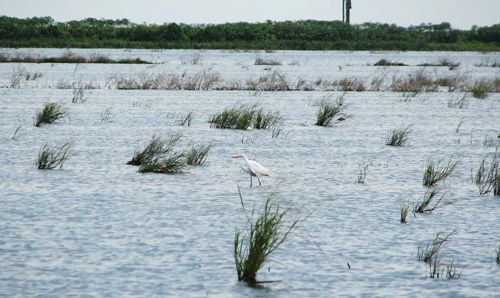
Credit: Ronald Cherry, UF/IFAS
Several weeks of continuous flooding are necessary to control Melanotus communis in the summer and longer in cooler months. Rice (Oryza sativa) as a rotation crop or fallow field flooding may eliminate the need to use a soil insecticide at sugarcane planting the following season (Cherry et al. 2011). In southern Florida, Jansson and Lecrone (1991) reported that oatmeal-corn flake and rolled oat baits were found to be the most attractive food baits tested for Melanotus communis and less time was required for processing traps with these baits. In southern Florida, fields are planted with cover crops in summer, and baits can be placed in the field during that time interval (1–2 months) between the disking of the cover crops (September–October) and planting of the cash crop (October–December). This reduced tuber damage by nearly 10% and saved up to $3300/ha in Florida (OEPP/EPPO 2005). Genung (1970) reported that a 3-2-3 weekly alteration of flooding, drying, and flooding was effective for controlling Melanotus communis. Delayed planting of corn is another method to reduce damage. Early-planted corn is susceptible to attack due to germinated seedlings growing slowly in cool and wet soil conditions. In Florida, different sugarcane varieties tolerant to wireworm attack have been studied. In a greenhouse study, out of 11 genotypes of sugarcane, CP 88-1762, CP 89-2143 and CP 03-1912 were reported to tolerate stand or biomass loss due to wireworm attack (Larsen et al. 2013). Cherry and Nuessly (2010) reported repellent effects of neem, Azadirachta indica (Aza-Direct®), treated soil on Melanotus communis for 14 days with repellency decreasing afterwards.
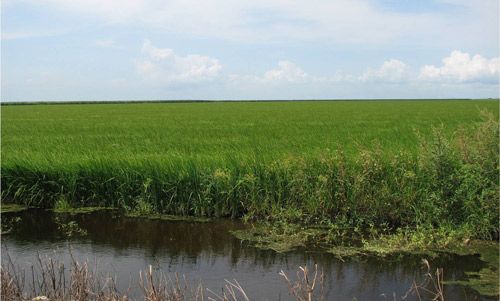
Credit: Ronald Cherry, UF/IFAS
Chemical Control
No insecticides are available for wireworm control once the crop is planted (Chaput 2011). Preplant broadcasting and furrow application of soil insecticides are common methods in potato fields in the United States as preventative measures. Until the 1980s, cyclodiene insecticides were used effectively in the United States for the control of wireworms, but due to their occurrence in nontarget species and slow degradation, they were eventually banned. After 1980, organophosphates and carbamates became the insecticides of choice for wireworm control. In the UK, the organophosphate insecticide Mocap 10G gave 100% control of the wireworm, Agriotes lineatus, in potatoes (Ansari et al. 2009).
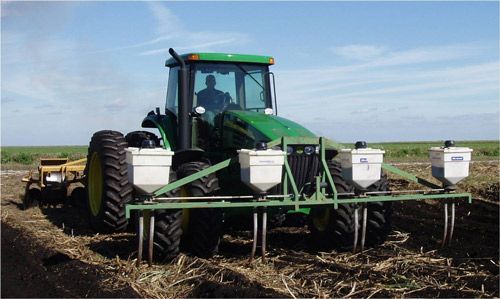
Credit: Ronald Cherry, UF/IFAS
The organophosphate insecticide Phorate was found to be effective for reducing stand loss and the number of wireworms in sugarcane (Larsen and Nuessly 2009). Application of organophosphates also gave inconsistent and contradictory results due to wireworm pressure, soil type and prevailing climatic conditions. In Virginia, insecticide application of fipronil, imidacloprid, thiamethoxam, and bifenthrin to the soil at potato planting provided 50%–80% wireworm control (Kuhara and Alvarez 2008). These new insecticides provide effective wireworm control with less environmental impact and fewer potential human safety concerns compared to organophosphates.
Selected References
Andrews N, Ambrosino M, Fisher G, Rondon SI. 2008. Wireworm Biology and Nonchemical Management in Potatoes in the Pacific Northwest. PNW-607, Oregon State University, University of Idaho, and Washington State University. (31 March 2020)
Anonymous. 1944. Wireworms and Food Production: A Wireworm Survey of England and Wales. Bulletin No. 128, Ministry of Agriculture and Fisheries. Published by His Majesty's Stationery Office, pp.1939–1942.
Ansari MA, Evans M, Butt TM. 2009. Identification of pathogenic strains of entomopathogenic nematodes and fungi for wireworm control. Crop Protection 28:269–272.
Baranowski RM, Waddill VH. 1975. Soil applications of insecticides for control of potato infesting wireworms. Proceedings of the Florida State Horticultural Society 88:173–175.
Bessin R, Townsend L. 2004. Wireworms. ENTFACT-120, College of Agriculture, Food and Environment. University of Kentucky, Lexington, KY, US. (31 March 2020).
Chaput J. 2011. Managing wireworms in vegetables crops. Ontario Ministry of Agriculture and Food, Ontario, Canada. (31 March 2020).
Cherry RH. 1988. Correlation of crop age with populations of soil insect pests in Florida sugarcane. Journal of Agricultural Entomology 5(4):241–245.
Cherry RH, Hall DG. 1986. Flight activity of Melanotus communis (Coleoptera: Elateridae) in Florida sugarcane fields. Journal of Economic Entomology 79:787–789.
Cherry R, Nuessly G. 2010. Repellency of the biopesticide, Azadirachtin, to wireworms (Coleoptera: Elateridae). Florida Entomologist 93(1):52–55.
Cherry RH, Hall DG, Gilbert RA. 2011. Wireworms in Florida sugarcane. ENY-665. Gainesville: University of Florida Institute of Food and Agricultural Sciences.
Cherry R, Grose P, Barbieri E. 2013. Validation of a sequential sampling plan for wireworms (Coleoptera: Elateridae) at sugarcane planting. Journal of Pest Science 86:29–32.
Fenton FA, Florence SC. 1926. Observations on the biology of Melanotus communis and Melanotus pilosus. Journal of Economic Entomology 19:502–504.
Fox CJS. 1961. The distribution and abundance of wireworms in the Annapolis Valley of Nova Scotia. The Canadian Entomologist 93:276–279.
Genung WG. 1970. Flooding experiments for the control of wireworms attacking vegetables in Everglades. The Florida Entomologist 53(2):55–64.
Gesell S. 1983. Wireworms as pests of field crops. Fact sheets, College of Agricultural Sciences, Entomology, Penn State, University Park, PA, US. (21 April 2022).
Hall DG. 1990. Stand and yield losses in sugarcane caused by the wireworm Melanotus communis (Coleoptera: Elateridae) infesting plant cane in Florida. Florida Entomologist 73:298–302.
Hall DG, Cherry RH. 1993. Effect of temperature in flooding to control the wireworm Melanotus communis (Coleoptera: Elateridae). Florida Entomologist 76:155–160.
Jansson RK, Lecrone SH.1989. Evaluation of food baits for pre-plant sampling of wireworms in potato fields in southern Florida. Florida Entomologist 72:503–510.
Jansson RK, Seal DR.1994. Biology and management of wireworms on potato. In: Zehender GW, Powelson ML, Jansson RK, Raman KV (eds.). Advances in potato pest management. pp. 31–53. APS Press, St Paul, US.
Kuhar TP, Doughty HB, Speese J III, Reiter S. 2008. Wireworm pest management in potatoes. Department of Entomology, Virginia Cooperative Extension, Virginia Tech, Virginia State University, Blacksburg, VA, US. (20 Nov 2013).
Kuhar TP, Alvarez JM. 2008. Timing of injury and efficacy of soil-applied insecticides against wireworms on potato in Virginia. Crop Protection 27:792–798.
Larsen NA, Nuessly GS. 2009. Effectiveness of reduced rates of insecticides for the control of Melanotus communis (Coleoptera: Elateridae) in sugarcane. Florida Entomologist 92:629–634.
Larsen NA, Nuessly GS, Cherry RH, Glaz B. 2013. Varietal susceptibility to the corn wireworm Melanotus communis (Coleoptera: Elateridae) in sugarcane. Journal of Pest Science 86:91–98.
OEPP/EPPO. 2005. Data sheets on quarantine pests Melanotus communis. Bulletin OEPP/EPPO Bulletin 35:380–382.
Rice M, Simmons C. 1999. Wireworm baits and preplant corn decisions. Integrated crop management. IC-482 (5), Department of Entomology, Iowa State University Extension, IA, US. (31 March 2020).
Riley TJ, Keaster AJ, Enns WR. 1974. Species of wireworms of the genus Melanotus associated with corn in Missouri. Journal of Economic Entomology 67:793.
Sorensen KA, Baker JR. 1994. Insects and related pests of vegetables-some important, common and potential pests in the south eastern United States. North Carolina Cooperative. Extension Service, Raleigh, NC, US. (20 Nov 2013).
Wilson JW. 1940. Preliminary report on wireworm investigations in the Everglades. Florida Entomologist 23:1–6.